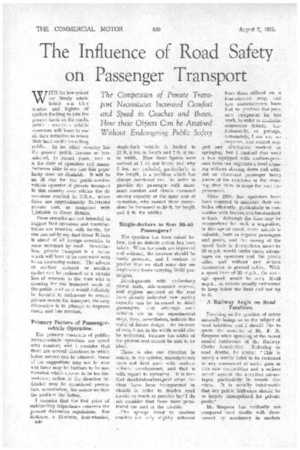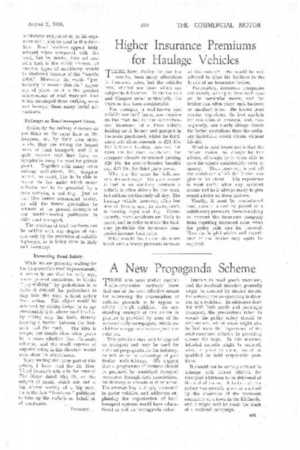The Influence of Road Safety on Passenger Transport
Page 36

Page 37

If you've noticed an error in this article please click here to report it so we can fix it.
WITH the low-priced car firmly established on the market and legions of cyclists flocking to join the present hosts on the roads, public service vehicle operators will have to use all their initiative to retain their hold on the travelling public. In no other country has the general public become so busminded, in recent years, and it is the duty of operators and manufacturers alike to see that this popularity does not diminish. It will be an ill day for the public-servicevehicle operator if private transport in this country ever attains the dimensions reached in U.S.A., where there are approximately 27,000,000 private cars, as compared with 1,500,000 in Great Britain.
These remarks are not intended to suggest that operators and manufacturers are troubled with inertia, for one can safely say that Great Britain is ahead of all foreign countries in mass transport by road. Nevertheless, private transport is a factor which will have to be contended with to an increasing extent. The advent of another motorist or another cyclist can be reckoned as a certain loss of revenue to the man who is catering for the transport needs of the public, and as it would definitely be harmful to endeavour to restrict private means for transport, the only alternative is to attempt to improve coach and bus services.
Primary Factors of Passengervehicle Operation.
The primary essentials of publicservice-vehicle operation are speed with comfort, and I consider that there are several directions in which better service can be attained. Some of the suggestions may not be new and there may be barriers to be surmounted which appear to be too formidable; action in the direction indicated may be considered premature, nevertheless, the sooner we face the problem the better.
I consider that the first point of outstanding importance concerns the present dimension regulations. For instance, a 32-seater, four-wheeled, B30
single-deck vehicle is limited to 27 ft. 6 ins, in length and 7 ft. 6 ins. in width. How these figures were arrived at I do not know, and why 6 ins, are included, particularly in the length, is a problem which has always perplexed me. In order to provide the passenger with maximum comfort and obtain increased seating capacity at the same cost of operation, why cannot these dimensions be increased to 30 ft. for length and 8 ft. for width?
Single-deckers to Seat 50-60 Passengers ?
The question has been raised before, but no definite action has been taken. When the roads are improved and widened, the increase should be easily procured, and I venture to predict that we shall some day see single-deck buses carrying 50-00 passengers.
Developments with underslung power units, side-mounted engines, and engines mounted at the rear have already indicated how seating capacity can be increased to 40-45 passengers, and, although such vehicles are in the experimental stage, they, nevertheless, indicate the trend of future design. An increase of even 6 ins, in the width would also be welcomed, because the width of the present seat cannot be said to be ideal.
There is also one direction in which, in my opinion, manufacturers have not kept pace with modern vehicle development, and that is with regard to springing. It is true that shocktabsorberseand other devices have been incorporated in chassis in order to deaden road shocks as much as possible but' I do not consider that these have penetrated the root of the trouble.
The springs fittedto modern coaches are only slightly different from those utilized on a four-wheeled dray, and tyre manufacturers have had to produce low-pressure equipment for bus work, in order to minimize suspension defects. Unfortunately, or, perhaps, fortunately, I am not an , engineer, and cannot suggest any alternative method of springing, but I contend that until a bus equipped with medium-pressure tyres can negotiate a level crossing without slowing down and without an observant passenger being aware of the existence of the crossing, then there is scope for vast improvement.
Since 1930, bus operators have been required to maintain their vehicles efficiently, particularly in connection with brakes, and the standard is high. Although the time may be inopportune for such a suggestion, in this age of speed, every minute is valuable, both as regards passengers and goods, and the raising of the speed limit in de-restricted areas to 35 m.p.h. would confer many advantages on operators and the public alike, and without any serious diminution in general safety. With a speed limit of 35 m.p.h., the average speed would be only 32-33 m.p.h., as drivers usually endeavour to keep below the limit and not up to it.
A Railway Angle on Road Fatalities.
Touching on the question of safety naturally brings us to the subject of road fatalities, and I should like to quote the remarks of Mr. F. B. Simpson when speaking at the recent annual conference of the Railway Clerks Association. Referring to road deaths, he states: "This is surely a terrific debit to be reckoned in any assessment of social gain in this new competition and a serious set-off against the admitted advantages, particularly in remote districts. It is socially indefensible that our public highways should be so largely monopolized for private profit."
Mr. Simpson has evidently not compared road deaths with those caused by machinery in modern workshops and !factories, as his argument could also be used in this direction.. Road fatalities appear insignificant when compared with this total, but he, surely, does not consider that, in the public interest, all modern types of machinery should be abolished because of this "terrific debit." Moreover the words " particularly in remote districts" appear out of place, as it is the greatest achievement of road transport that it has developed these outlying areas and brought them many social advantages.
Railways as Road-transport Users.
Evidently the railway directors do not think on the same lines as Mr. Simpson, as, by their own statements, they are among the largest users of road transport, and it is quite evident that they have no scruples in using the road for private profit. Together with many other railway enthusiasts, Mr. Simpson would, no doubt, like to be able to revive the law under which motor vehicles had to be preceded by a man carrying a red flag. Just as this idea causes amusement to-day, so will the future generation be amused at the present attempts of our muddle-headed politicians to stifle road transport.
The problem of road accidents can be tackled with any degree of suc cess only by the provision of suitable highways, as is being done in Italy and Germany.
Increasing Road Safety.
While we are patiently. waiting for the long-overdue road improvements, it occurs to me that the only way, under present conditions, to hinder 'jay-walking" by pedestrians is to make it difficult for pedestrians to step into the road without noting their action. This object would be achieved.by raising footpaths to approximately 2 ft. above road level or by raising only the kerb, ,thereby forming a barrier between the foot
path and the road. The idea is simple, but simple ideas often prove to be more effective than elaborate schemes, and the small expense of experimenting in this direction would soon show its effectiveness.
Since writing the latter part of this article, I have read the Rt. Hon. Lloyd George's article in the issue of The Motor dated May 21, on the subject of roads, which sets out a big scheme worthy of a big man. He is the first " froht-row " politician to take up the cudgels on behalf of all road-users.
TRANSEX.












































































